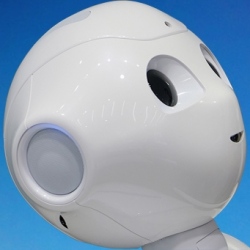
Whether we like it or not, and there may be reasons to be against them, robots are going to continue to be developed and will one day permeate our lives. A Pew report conducted last year predicted that robots and artificial intelligence will be across most of our daily lives by 2025. This included in our homes.
The humanoid Pepper robot with its large eyes and sweeping curves, from Aldebaran, has had a meteoric rise to fame as one of the first robots that you can buy to be used in the home.
It’s been designed to “help people grow, enhance their life, facilitate relationship,” provide some services and be useful to people. In essence, the robot is everything that a home robot should be, and the demand for it shows this.
But, while being impressive, selling a couple of thousand robots to early adopters is a long way from global domination. “Having robots in every home is really about acceptance,” said Magali Cubier from Aldebaran. “On our side we strive to make robots that are interactive and cute and will draw people to them.”
Pepper and other robots mark the first generation of home robots that are intended to make our lives easier. In the short term Cubier said that Pepper will be able to “assist with scheduling, remembering appointments, entertaining the family, assisting children with homework, as well as with broader tasks like home surveillance, connection and communication.”
But looking towards future generations of the robot, she believes Pepper’s development may be similar to the way mobile phones have come to be adopted globally.
“As the library of applications grows, Pepper will be able to be more and more useful for a wider range of tasks, but also more adapted to each family or home,” she said.
“This evolution will probably happen in a similar way, with gradual use, to smartphones; from one simple feature, calling, expanding into games, internet, directions and all sorts of apps that we use on a daily basis.”
